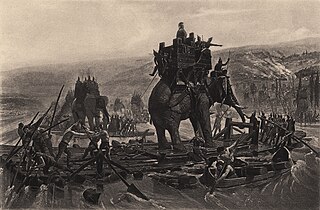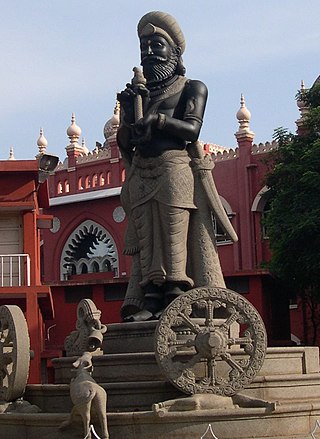Related Research Articles

A war elephant is an elephant that is trained and guided by humans for combat purposes. Historically, the war elephant's main use was to charge the enemy, break their ranks, and instill terror and fear. Elephantry is a term for specific military units using elephant-mounted troops. In modern times, war elephants on the battlefield were effectively made redundant by the invention of motor vehicles, particularly tanks.

The flag of Sri Lanka, also called the Sinha Flag or Lion Flag, consists of a golden lion holding a kastane sword in its right fore-paw in a maroon background with four gold bo leaves, one in each corner. This is bordered by gold, and to its left are two vertical stripes of equal size in teal and orange, with the orange stripe closest to the lion. The lion and the maroon background represent the Sinhalese race, while the saffron border and four bo leaves represent the concepts of meththa, karuṇā, muditā and upecka respectively. The stripes represent the country's two largest minority ethnicities, with the orange representing the Tamils inhabitants—namely the Sri Lankan Tamils and the Indian Tamils of Sri Lanka—and the teal stripe representing the Sri Lankan Moors. The golden yellow border is a catch-all representing the various minority communities of the country.

Dutugamunu, also known as Duṭṭhagāmaṇī Abhaya, was a king of the Anuradhapura Kingdom who reigned from 161 BC to 137 BC. He is renowned for first uniting the whole island of Sri Lanka by defeating and overthrowing Elara, a Tamil king from the Chola Kingdom, who had invaded the Anuradhapura kingdom in 205 BC. Dutugamunu also expanded and beautified the city of Anuradhapura and projected the power of the Rajarata kingdom across the island of Sri Lanka.

Ellalan, also referred to as Elara the Pious, and by the honorific epithet Manu Needhi Cholan, was a member of the Tamil Chola dynasty in Southern India, who upon capturing the throne became king of the Anuradhapura Kingdom, in present-day Sri Lanka, from 205 BCE to 161 BCE.
Gajabahu I, also known as Gajabahuka Gamani, was a Sinhalese king of Rajarata in Sri Lanka. He is renowned for his military prowess, religious benefactions, extensive involvement in South Indian politics, and for possibly introducing the cult of the goddess Pattini to Sri Lanka. The primary source for his reign is the Mahavamsa, though he is also the only early Sri Lankan king to be extensively mentioned in the Chera Cilappatikaram.

Dakkhina Stupa is a 2nd-century BC large brick Stupa in Anuradhapura, Sri Lanka. Earlier thought to be a monument of King Elara, it was later identified as the Stupa of ancient Dakini (Dakkhina) Vihara by Senarath Paranavithana with the help of a Brahmi inscription of the 3rd century A.D. unearthed from the ground between the southern and western Vahalkadas of the Stupa.
Atamasthana or Eight sacred places are a series of locations in Sri Lanka where the Buddha had visited during his three visits to the country. The sacred places are known as Jaya Sri Maha Bodhiya, Ruwanwelisaya, Thuparamaya, Lovamahapaya, Abhayagiri Dagaba, Jetavanarama, Mirisaveti Stupa and Lankarama. They are situated in Anuradhapura, the capital of the ancient Anuradhapura Kingdom.

Stupas, also called dagebas and cetiyas, are considered an outstanding type of architectural creation of ancient Sri Lanka. Under the influence of Buddhism, there were several changes in the field of architecture in Sri Lanka. The stupa commands a prominent place among these changes. The Stupa is also known by synonymous names such as Chaithya, Dagaba, Thupa, Seya and Vehera. Stupas designed and constructed in Sri Lanka are the largest brick structures known to the pre-modern world.
Much is written of the war of 205 BC to 161 BC between Sinhala King Dutugemunu and Ellalan for the city of Anuradhapura, and the central role played by Dutugemunu's Ten Giant Warriors or Ten Great Giants. According to the chronicle Mahavamsa the men were drafted into Royal service during the reign of Dutugemunu's father, King Kavantissa.

Deeghawapi is a Buddhist sacred shrine and an archaeological site in the Ampara District of Sri Lanka, boasting of historical records dating back to the 3rd century BCE. Water reservoirs, called "tanks", were an important feature of the hydraulic civilization of ancient Sri Lanka, and temples and cities were built around them. The importance of Dighavapi is connected with legends about visits to this site by the Buddha himself, and many allusions to Deeghawapi in the ancient chronicles as well as in the Pali literature. It has also played a role in the political history of the region. In more recent (medieval) times, the Sinhalese kings have settled Moor and Dutch settlers in the neighbouring areas. The construction is expected to be finished by the end 2023.
Maha Pambata, or 'Big Rock' is a famous war elephant belonging to the Tamil King Ellalan.

Elephant duels were a historical martial practice where opposing army leaders engaged each other on the battlefield in single combat on the back of war elephants. They are documented in historical records from Southeast Asia, mainly in present-day Cambodia from the 11th Centuries and Burma and Thailand from the 13th to 16th centuries.

Viharamahadevi (Sinhala:විහාරමහාදේවි) was the mother of King Dutugamunu, Saddhatissa and the Queen consort of King Kavantissa. Some scholars suggest that her original name was 'śavera', which possibly means goddess of the night.
Maha Sona or Maha Sohona is a yaka in Sinhalese folklore, said to haunt the afterlife. The name Maha Sona denotes "the greatest demon" or "god or demon of the cemetery" in the Sinhala language. He is one of the most feared and commonly know gods or demons in Sri Lanka. According to popular folklore, he was originally a giant who was defeated and decapitated in a duel by another giant, Gotaimbara. His head was then replaced with that of a bear or tiger. He is believed to kill people by crushing their shoulders or by afflicting them with disease. Traditional exorcism rituals are performed to repel the demon in such cases. The Sri Lankan Army's Long Range Reconnaissance Patrol units are popularly known as the "Maha Sohon Brigade", named after this demon.
The Battle of Vijithapura was a decisive battle fought in the campaign carried out by Sri Lankan king Dutthagamani against the invading South Indian king Ellalan. The battle is documented in detail in the ancient chronicles of the country. However, they only provide the viewpoint of Dutthagamani and his army, and details are scarce on Elara's side.

Kataragama deviyo is a guardian deity of Sri Lanka. A popular deity who is considered to be very powerful, shrines dedicated to Kataragama deviyo are found in many places of the country. Sinhalese Buddhists believe him also as a divine patron of the Buddha Sasana in Sri Lanka. An ancient temple dedicated to God Kataragama, known as Ruhunu Maha Kataragama Devalaya is situated in the South-Eastern town of Kataragama in Monaragala District of Uva Province.

According to the Mahāparinibbāṇa Sutta, after attaining parinirvana, the body of Buddha was cremated and the ashes divided among his lay followers.

The Somawathiya Chaitya is a Buddhist Stupa situated in the ancient city of Polonnaruwa, Sri Lanka. Chaitya premises is called the Somawathiya Rajamaha Viharaya.
References
- ↑ "Kandula – the little elephant of the Army". sundaytimes.lk. Retrieved 2009-08-21.